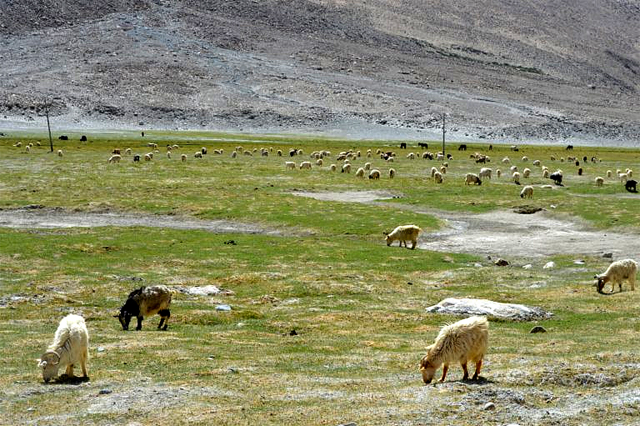The environment and conservation website Mongabay.com posted a news story last week on the threats that feral dogs are posing to the survival of black-necked cranes. The reporter, Athar Parvaiz, discusses the damage that wild dogs do to the crane eggs and the chicks in the nests, as well as to other wildlife in the high mountains of Ladakh.

The crane is the official bird of the entire state of Jammu and Kashmir, of which Ladakh is a part. It nests in the the Changthang region of Ladakh, the plateau near the border with Tibet. It is a significant symbol to many Ladakhi communities since it has become a spiritually and culturally important icon. The Ladakhi revere the bird, featuring it in every festival and program in the region. Even the monasteries have paintings of the cranes along with images of other spiritual subjects. Sighting the big birds brings good luck.
According to Jigmat Takpa, a forest conservator of Ladakh, a dance performed by the birds, called the Chartses, “is performed by Ladakhis in every cultural event and festival.” He added that the bird is considered to be auspicious—a symbol of the unique ecology of Ladakh. “Ladakhis feel proud about the fact that its only breeding ground in India is in Ladakh,” Mr. Takpa said.

But dogs, particularly feral ones, are threatening the cranes. According to the World Wildlife Fund India, dogs damage the nests and eggs of the huge birds. The WWF points out that dogs are owned by the local nomads in the Changthang as well as by armed forces personnel in the region. The IUCN classifies the black-necked crane as a vulnerable species because of its small, and declining, population. Another threat to the cranes, in addition to feral dogs, is the degradation of their habitat—the loss of wetlands and changing agricultural practices.
Mr. Takpa went on to say that dogs are not only a threat to the cranes, they are also becoming dangerous to people. He wondered how the big birds can continue to escape the depredations of the feral animals. According to wildlife officials in Leh, dogs pose a threat to other wildlife as well, including even snow leopards. The regional wildlife warden for Ladakh, Sajid Sultan, shows the journalist some photos of feral dogs in the Changthang region attacking wildlife, including cranes and leopards.
Mr. Sultan was asked about the measures his department is taking to protect the animals. He replied that the department is working with the Snow Leopard Conservation India Trust, the Wildlife Conservation and Bird Club of Ladakh, and the Nature Conservancy Foundation to survey the population of dogs in the Changthang. They came up with an estimate of 3,500. Out of that, 1,200 dogs live within a 10 km radius of 13 crane breeding areas.

Narendra Patil, a researcher who participated in the survey, told the reporter that in a few cases humans have been attacked, mauled, and even devoured by feral dogs. Their attacks on wild animals have been reported widely. The researchers interviewed people in 40 Changthang villages and, Patil noted, “dogs are very unambiguously perceived as a threat to people, livestock and wildlife.” He added that virtually everyone the team interviewed said that the number of freely-roaming dogs needs to be controlled. They believe that the dogs feed on the food waste produced at tourist camps and military installations.
Mr. Patil said that the breeding success rate of the cranes in Ladakh has been declining sharply, from a 60 percent success rate in 1995 to less than half of that, 29 percent, in 2016—all due to dog predation on the nests and eggs of the birds. He supplied additional figures. The total population of black-necked cranes in Ladakh in 2014 was down to 112 birds, of which there were only 17 breeding pairs.
In volume 4/5 of the series Proceedings of the International Colloquia on Ladakh—standard reference sources for this peaceful society, by the way—Mallon and Prodon argue that prohibitions by Buddhism against killing may have an effect on controlling the numbers of active hunters in Ladakh. This control may have helped preserve the numbers of wildlife, such as the black-necked cranes. Furthermore, restrictions on hunting have been enforced, though some illegal hunting undoubtedly does go on. But it is pursued on a limited scale and Ladakh has not experienced the whole scale slaughter of wildlife that has plagued other areas in the Himalayas, though there are exceptions.